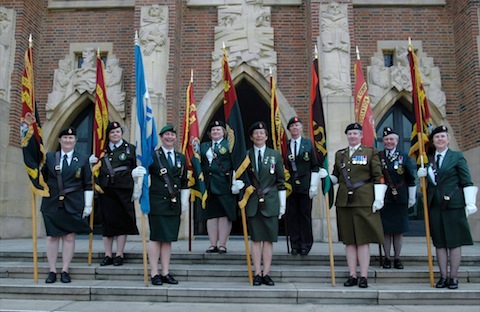 Abraham Lincoln
If given the truth, the people can be depended upon to meet any national crisis...
Abraham Lincoln
If given the truth, the people can be depended upon to meet any national crisis...
 Guildford news...
for Guildford people, brought to you by Guildford reporters - Guildford's own news service
Guildford news...
for Guildford people, brought to you by Guildford reporters - Guildford's own news service
Rededication Service for Women’s Royal Army Corps Association at Guildford Cathedral
Published on: 26 May, 2012
Updated on: 28 May, 2012
A service of rededication and renewal of links between the Women’s Royal Army Corps Association (WRACA) and Guildford Cathedral was held there on Sunday, May 20.
The WRACA incorporates the Queen Mary’s Army Auxiliary Corps (QMAAC) and Auxiliary Territorial Service Comrades’ Association (ATSCA), and members of these groups along with invited guests attended the service.
During the mattins service the QMAAC and Auxiliary Territorial Service standards were ‘laid up’ in the Cathedral Gallery alongside other regimental standards.
The service was conducted by the Dean of Guildford Cathedral, The Very Rev’d Victor Stock, and the standards were ‘presented’ by Brigadier Nicky Moffat CBE. Following the service a luncheon was held in The Refectory.
Invited guests included The Lord-Lieutenant of Surrey, Dame Sarah Goad DCVO JP, the Mayor of Guildford, Jenny Jordan: Honorary Freemen David Watts, Bill Bellerby and Doreen Bellerby, Mary Lloyd-Jones; Honorary Alderman Bernard Park and Guildford Borough Councillor Jennifer Powell.
Both the ATS and the WRAC were trained at Queen Elizabeth Camp, Stoughton, Guildford. Literally thousands of servicewomen and officers passed through its gates.
While Guildford Cathedral was being constructed, WRAC recruits were taken to the site on Stag Hill ‘to buy a brick’. In 1994 a commemorative window was unveiled in the cathedral by the Duchess of Kent on the 75th anniversary of the association. In 2003, the Queen, who was an ATS officer herself, became patron of the association.
The WRACA celebrated its 90th anniversary in 2009 – 90 years of comradeship, commitment and service by generations of women who were proud to serve their country through different conflicts and times, whether in the QMAAC during the First World War, the ATS during the Second World War, or in the WRAC post 1949.
The association’s legacy lives on today and has allowed women to serve in almost every area of today’s British Army alongside their male colleagues.

"Found any?" - "Nope, it all looks green to me!" (See Opinion: The Future is Congested, the Future is Grey)
www.abbotshospital.org/news/">





Recent Articles
- Latest Evidence in Sara Sharif Trial
- Ash’s New Road Bridge Is Named – and November 23rd Is Opening Day
- Class A in Underwear Leads to Jail Sentence
- Historical Almshouse Charity Celebrates Guildford in Bloom Victory
- Notice: Shalford Renewable Showcase – November 16
- Firework Fiesta: Guildford Lions Club Announces Extra Attractions
- Come and Meet the Flower Fairies at Watts Gallery
- Updated: Royal Mail Public Counter in Woodbridge Meadows to Close, Says Staff Member
- Letter: New Developments Should Benefit Local People
- Open Letter to Jeremy Hunt, MP: Ash’s Healthcare Concerns


Search in Site
Media Gallery
Dragon Interview: Local Artist Leaves Her Mark At One of England’s Most Historic Buildings
January 21, 2023 / No Comment / Read MoreDragon Interview: Lib Dem Planning Chair: ‘Current Policy Doesn’t Work for Local People’
January 19, 2023 / No Comment / Read MoreA3 Tunnel in Guildford ‘Necessary’ for New Homes, Says Guildford’s MP
January 10, 2023 / No Comment / Read More‘Madness’ for London Road Scheme to Go Ahead Against ‘Huge Opposition’, Says SCC Leader
January 6, 2023 / No Comment / Read MoreCouncillor’s Son Starts Campaign for More Consultation on North Street Plan
December 30, 2022 / No Comment / Read MoreCounty Council Climbs Down Over London Road Works – Further ‘Engagement’ Period Announced
December 14, 2022 / No Comment / Read MoreDragon Interview: GBC Reaction to the Government’s Expected Decision to Relax Housing Targets
December 7, 2022 / No Comment / Read MoreHow Can Our Town Centre Businesses Recover? Watch the Shop Front Debate
May 18, 2020 / No Comment / Read More









Recent Comments